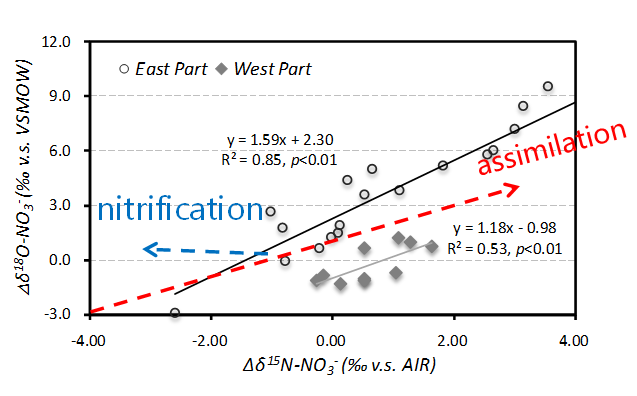Estuaries are regions of active land-ocean interaction and play an important role in regulating material fluxes from land to sea. The biogeochemical processes of riverine-borne materials occurred during estuarine mixing, in particular the associated nitrogen (N) cycling and turnover processes, have received considerable concerns. However, the geochemical behavior of N in estuarine zones is rather complex, due to a combination of freshwater-seawater mixing, chemical and biological processes, as well as the existence of time-varying or multiple anthropogenic N inputs. As the second largest estuary in China in terms of river discharge, the possibility of significant N turnover processes in the Pearl River Estuary is still a matter of debate. On one hand, physical mixing between freshwater and seawater strongly affects the N distribution in this river-dominated estuary, and water residence time is relatively short, it would therefore unlikely to exist major N production and removal processes. On the other hand, the shift in limiting nutrients (from P limitation in upper estuary to N limitation in coastal waters) suggests a more rapid N removal or turnover rates than P.
To elucidate the N sources and turnover processes in the Pearl River Estuary, Prof. WEI Gangjian’s research group in Guangzhou Institute of Geochemistry, Chinese Academy of Sciences analyzed δ15N-δ18O dual isotopes of dissolved nitrate and δ15N of dissolved ammonium and suspended particulate matters across the salinity gradient in different seasons, including the flooding events. Our results suggest that:
(1) High δ15N values of nitrate at low salinities indicate that sewage is a significant source of nitrate, up to 19% as calculated from a two end-member mixing model. Simultaneous nitrate assimilation by phytoplankton and nitrification occurred within the estuary. Higher degree of nitrification was found in the east PRE than the west PRE, most likely due to different water velocities and residence time in the two areas.
(2) Isotope measurements of dissolved nitrate, ammonium and suspended particulate matters reflect a strong coupling between assimilation and remineralization in summers, whereas decoupling between them occurs during winters largely due to intense sediment-water interaction and resuspension of sediment. In the coastal regions, atmospheric deposition may contribute significantly to nitrate delivery in winters.
(3) The isotopic ratios of particulate organic matter (POM) follow seasonal climatic and hydrological cycles well, which were in turn controlled by river discharge and temperature-modulated biological processes (i.e., assimilation and remineralization). Terrestrial OM and freshwater phytoplankton were the major components of POM within the estuary and shelf areas, whereas marine phytoplankton was the dominant component in the adjacent coastal water with mid-salinities. This pattern indicates that seasonal flooding has a profound effect on material dynamics in coastal regions.
These studies were financially supported by the National Key R&D Program of China (2016YFA0601204), the National Natural Science Foundation of China (41325012, 41306102, and 41506095), etc.
Please see:
[1] Ye, Feng; Guo, Wei; Shi, Zhen; Jia, Guodong; Wei, Gangjian. Seasonal dynamics of particulate organic matter and its response to flooding in the Pearl River Estuary, China, revealed by stable isotope (δ13C and δ15N) analyses. Journal of Geophysical Research-Oceans, 2017, 122: 6835-6856.
[2] Ye, Feng; Jia, Guodong; Xie, Luhua; Wei, Gangjian; Xu, Jie. Isotope constraints on seasonal dynamics of dissolved and particulate N in the Pearl River Estuary, south China. Journal of Geophysical Research-Oceans, 2016, 121: 8689-8705.
[3] Ye, Feng; Ni, Zhixin; Xie, Luhua; Wei, Gangjian; Jia, Guodong. Isotopic evidence for turnover of biological reactive nitrogen in the Pearl River Estuary, south China. Journal of Geophysical Research-Biogeosciences, 2015, 120: 661-672.

Figure 1 Δδ15N and Δδ18O of dissolved nitrate in mid- and high-salinity waters of the Pearl River Estuary (PRE). Open circles and grey diamonds represent samples from the west and east PRE, respectively

Figure 2 Schematic of the sources and biogeochemical processes of POM in the Pearl River Estuary at different seasons based on δ13C and δ15N values.